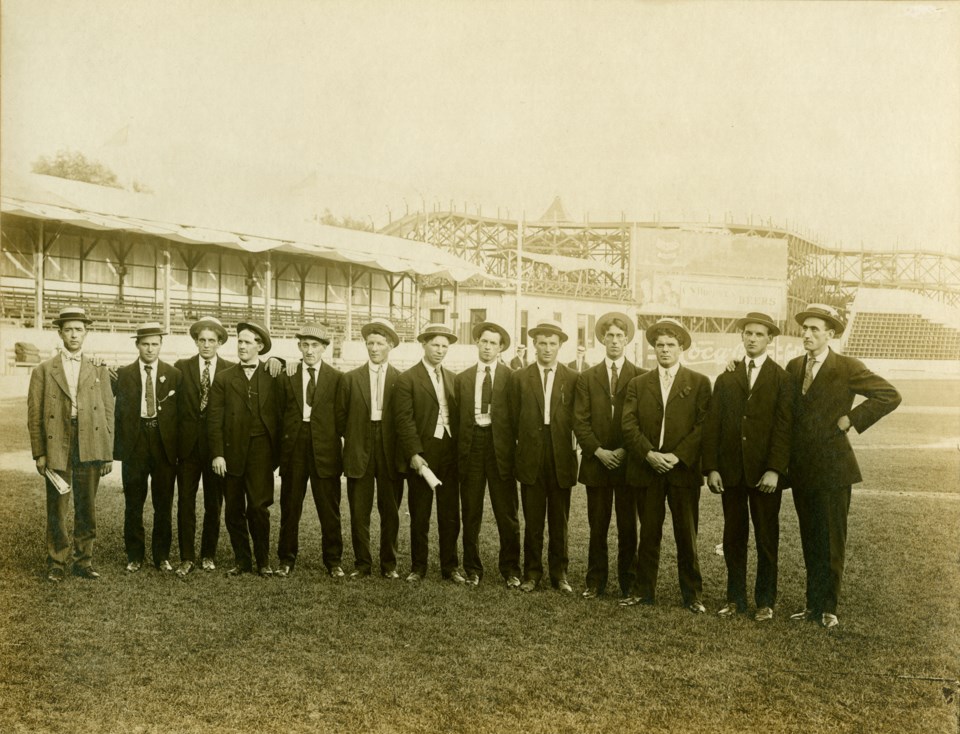Originally a sport played by the Iroquois and Algonquin peoples, an adapted version of (field) lacrosse was played in New Westminster by at least the 1800s. The first official lacrosse club was set up in the Royal City in 1888. The first lacrosse game was played in June of 1889.
According to one legend, the team got its iconic “Salmonbellies” name when, wearing salmon-red sweaters, the New Westminster team was taunted by their rivals as “salmon-bellies”, a slur basically referring to the weakest part of the fish. For whatever reason, the Salmonbellies players and fans adopted the name, and it stuck. By 1897, the name was being referenced in newspaper reports about the team.
There have been plenty of highs and lows in the Salmonbellies 125 year history. The Record asked the man who literally wrote the book on the history of the Salmonbellies, Bruce MacDonald (author of Salmonbellies Versus The World: The story of the most famous team in lacrosse and their greatest rivals), and senior Salmonbellies president and general manager Dan Richardson to each share a few highlights of the ’Bellies long history.
MacDonald said the first highlight was when the Salmonbellies beat the reigning champion Montreal Shamrocks in 1908 to win the Minto Cup for the first time. (Nowadays, the juniors play for the Minto Cup, but back in the day there was no Mann Cup, teams just played for the Minto.)
Before the Salmonbellies took the cup in 1908, Montreal had won it since its conception in 1901.
“It was a complete shock. Today it would be like a team from Smithers plays the Chicago Blackhawks for the Stanley Cup, and wins. It was just impossible,” said MacDonald.
When the team returned home to New Westminster, the Minto Cup was proudly displayed in Thomas Gifford’s jewelry store on Columbia Street.
MacDonald’s second pick for an historical Salmonbellies’ highlight was during the 1920s, generally a time when there was a lot of turmoil in lacrosse in Canada as the game had lost some popularity during the First World War.
The Salmonbellies were the dominant team during the ‘20s, but the 1927 Mann Cup was extra special.
“By winning that 1927 Mann Cup the Salmonbellies earned the right to represent Canada at the 1928 Olympic Games in Amsterdam,” said MacDonald. (Lacrosse was a demonstration sport at the 1928 Summer Olympics.)
“That is the only instance of a single team in lacrosse or maybe in any other sport, that competed in the Olympics… and it was a team from New Westminster,“ said MacDonald.
The team was made up of all Salmonbellies players, but they were representing Canada.
“They were all young men and they were all raised in New Westminster,” he said.
The players had to raise about $29,000 (equivalent of close to $400,000 today) for the trip, which, thanks to community support, they did.
MacDonald’s third and final pick for a historical Salmonbellies highlight was in 1937 when, after several years of struggling, the Salmonbellies won the Mann Cup. (In 1932 the B.C. league switched over to box lacrosse, which lead to the team’s years of lackluster play.)
In the ‘37 Mann Cup, the Salmonbellies defeated the reigning three-time Canadian champion Orillia Terriers. To achieve this the then Salmonbellies general manager and president – and Royal City mayor – Fred Hume had hired the three best players off the Orillia Terriers.
“He brought them to New Westminster and gave them jobs and everything,” said MacDonald, with a laugh.
MacDonald said this kind of extreme action by Hume is an example of the passion for the Salmonbellies many in New Westminster have demonstrated over the years.
“What these people do, doesn’t make a lot of sense,” he said. “They spend tons of money and they don’t get a lot of recognition, they just do it out of love.”
Richardson’s picks for Salmonbellies highlights includes the era between 1915 and 1925 referenced by MacDonald.
“We won nine of 11 Canadian championships (Mann Cups),” Richardson said.
He also chose the period from 1968- 76 because of the number of championships the team wracked up during that period.
“(Between) 1968 and 1976 we won a world championship and four out of seven Canadian championships,” he said. It is a period he has hoped to recreate with his modern-day team.
Richardson’s final highlight pick was just this past summer when the Salmonbellies celebrated their 125th anniversary with an alumni gala event at the Starlight Casino attended by about 250 former players, their families and supporters.
Richardson said the anniversary shows the continued strong bond between the four levels of Salmonbellies lacrosse: alumni, seniors, junior, minors, coupled with the city and community.
“You will not find the history, the green wooden floor, the success, the partnership, the bond, the pride, the community spirit anywhere else in Canada than what the Salmonbellies have,” Richardson said.



